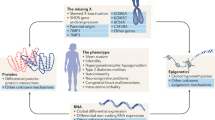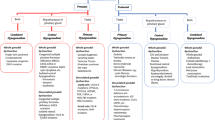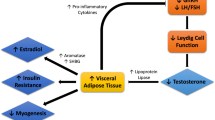Abstract
Klinefelter syndrome is the most common sex-chromosome disorder; it affects approximately one in every 660 men. This syndrome is characterized by the presence of one or more extra X chromosomes, and the karyotype 47,XXY is the most prevalent type. The 'prototypic' man with Klinefelter syndrome has traditionally been described as tall, with narrow shoulders, broad hips, sparse body hair, gynecomastia, small testicles, androgen deficiency, azoospermia and decreased verbal intelligence. A less distinct phenotype has, however, been described. Klinefelter syndrome is an underdiagnosed condition; only 25% of the expected number of patients are diagnosed, and of these only a minority are diagnosed before puberty. Patients with Klinefelter syndrome should be treated with lifelong testosterone supplementation that begins at puberty, to secure proper masculine development of sexual characteristics, muscle bulk and bone structure, and to prevent the long-term deleterious consequences of hypogonadism; however, the optimal testosterone regimen for patients with Klinefelter syndrome remains to be established.
Key Points
-
Klinefelter syndrome is the most common sex-chromosome aberration (present in 1 in 660 men), but remains underdiagnosed
-
Common clinical findings in patients with Klinefelter syndrome include small testes (<4 ml), azoospermia, hypergonadotrophic hypogonadism, learning disabilities, gynecomastia, and cryptorchidism
-
Patients with Klinefelter syndrome have an increased risk of developing diabetes, metabolic syndrome, osteoporosis, breast cancer, mediastinal germ-cell tumors and non-Hodgkin's lymphoma
-
Treatment for patients with Klinefelter syndrome can include referral to a speech therapist if necessary (in cases where speech development is delayed) and testosterone treatment from puberty (when gonadotropin levels rise)
-
Infertility in some men with Klinefelter syndrome can be overcome by use of assisted reproduction techniques: testicular sperm extraction and subsequent intracytoplasmatic sperm injection
This is a preview of subscription content, access via your institution
Access options
Subscribe to this journal
Receive 12 print issues and online access
$209.00 per year
only $17.42 per issue
Buy this article
- Purchase on Springer Link
- Instant access to full article PDF
Prices may be subject to local taxes which are calculated during checkout


Similar content being viewed by others
References
Klinefelter H et al. (1942) Syndrome characterized by gynecomastia, aspermatogenesis without a-leydigsm and increased secretion of follicle-stimulating hormone. J Clin Endocrinol Metab 2: 615–622
Jacobs PA and Strong JA (1959) A case of human intersexuality having a possible XXY sex-determining mechanism. Nature 183: 302–303
Maclean N and Mitchell JM (1962) A survey of sex-chromosome abnormalities among 4,514 mental defectives. Lancet 1: 293–296
Nielsen J et al. (1982) Follow-up until age 7 to 11 of 25 unselected children with sex chromosome abnormalities. Birth Defects Orig Artic Ser 18: 61–97
Robinson A et al. (1990) Sex chromosome aneuploidy: the Denver Prospective Study. Birth Defects Orig Artic Ser 26: 59–115
Ratcliffe S (1999) Long-term outcome in children of sex chromosome abnormalities. Arch Dis Child 80: 192–195
Smyth CM and Bremner WJ (1998) Klinefelter syndrome. Arch Intern Med 158: 1309–1314
Simpson JL et al. (2003) Klinefelter syndrome: expanding the phenotype and identifyig new research directions. Genet Med 5: 460–468
Swerdlow AJ et al. (2005) Mortality in patients with Klinefelter syndrome in Britain: a cohort study. J Clin Endocrinol Metab 90: 6516–6522
Jacobs PA et al. (1988) Klinefelter's syndrome: an analysis of the origin of the additional sex chromosome using molecular probes. Ann Hum Genet 52 (Pt 2): 93–109
MacDonald M et al. (1994) The origin of 47,XXY and 47,XXX aneuploidy: heterogeneous mechanisms and role of aberrant recombination. Hum Mol Genet 3: 1365–1371
Bojesen A et al. (2003) Prenatal and postnatal prevalence of Klinefelter syndrome: a national registry study. J Clin Endocrinol Metab 88: 622–626
Hook EB (1981) Rates of chromosome abnormalities at different maternal ages. Obstet Gynecol 58: 282–285
Shi Q et al. (2002) Absence of age effect on meiotic recombination between human X and Y chromosomes. Am J Hum Genet 71: 254–261
Zitzmann M et al. (2004) X-chromosome inactivation patterns and androgen receptor functionality influence phenotype and social characteristics as well as pharmacogenetics of testosterone therapy in Klinefelter patients. J Clin Endocrinol Metab 89: 6208–6217
Nielsen J and Wohlert M (1990) Sex chromosome abnormalities found among 34,910 newborn children: results from a 13-year incidence study in Arhus, Denmark. Birth Defects Orig Artic Ser 26: 209–223
Leonard MF et al. (1979) Chromosomal abnormalities in the New Haven newborn study: a prospective study of development of children with sex chromosome anomalies. Birth Defects Orig Artic Ser 15: 115–159
Maclean N and Edin MB (1964) Sex-chromosome abnormalities in newborn babies. Lancet 1: 286–290
Abramsky L and Chapple J (1997) 47,XXY (Klinefelter syndrome) and 47,XYY: estimated rates of and indication for postnatal diagnosis with implications for prenatal counseling. Prenat Diagn 17: 363–368
Robinson A et al. (1979) Summary of clinical findings: profiles of children with 47,XXY, 47,XXX and 47,XYY karyotypes. Birth Defects Orig Artic Ser 15: 261–266
Lanfranco F et al. (2004) Klinefelter's syndrome. Lancet 364: 273–283
Denschlag D et al. (2004) Assisted reproductive techniques in patients with Klinefelter syndrome: a critical review. Fertil Steril 82: 775–779
Muller J et al. (1995) Quantified testicular histology in boys with sex chromosome abnormalities. Int J Androl 18: 57–62
Wikstrom AM et al. (2004) Klinefelter syndrome in adolescence: onset of puberty is associated with accelerated germ cell depletion. J Clin Endocrinol Metab 89: 2263–2270
Christiansen P et al. (2003) Longitudinal studies of inhibin B levels in boys and young adults with Klinefelter syndrome. J Clin Endocrinol Metab 88: 888–891
Salbenblatt JA et al. (1985) Pituitary–gonadal function in Klinefelter syndrome before and during puberty. Pediatr Res 19: 82–86
Ross JL et al. (2005) Early androgen deficiency in infants and young boys with 47,XXY Klinefelter syndrome. Horm Res 64: 39–45
Lahlou N et al. (2004) Inhibin B and anti-Mullerian hormone, but not testosterone levels, are normal in infants with nonmosaic Klinefelter syndrome. J Clin Endocrinol Metab 89: 1864–1868
Ratcliffe SG (1982) The sexual development of boys with the chromosome constitution 47,XXY (Klinefelter's syndrome). Clin Endocrinol Metab 11: 703–716
Bay K et al. (2005) Insulin-like factor 3 serum levels in 135 normal men and 85 men with testicular disorders: relationship to the luteinizing hormone–testosterone axis. J Clin Endocrinol Metab 90: 3410–3418
Bojesen A et al. (2006) The metabolic syndrome is frequent in Klinefelter's syndrome and is associated with abdominal obesity and hypogonadism. Diabetes Care 29: 1591–1598
Schiff JD et al. (2005) Success of testicular sperm extraction [corrected] and intracytoplasmic sperm injection in men with Klinefelter syndrome. J Clin Endocrinol Metab 90: 6263–6267
Gonsalves J et al. (2005) Recombination in men with Klinefelter syndrome. Reproduction 130: 223–229
Ron-El R et al. (2000) A 47,XXY fetus conceived after ICSI of spermatozoa from a patient with non-mosaic Klinefelter's syndrome: case report. Hum Reprod 15: 1804–1806
Bojesen A et al. (2006) Morbidity in Klinefelter syndrome: a Danish register study based on hospital discharge diagnoses. J Clin Endocrinol Metab 91: 1254–1260
Tsai EC et al. (2000) Low serum testosterone level as a predictor of increased visceral fat in Japanese-American men. Int J Obes Relat Metab Disord 24: 485–491
Laaksonen DE et al. (2004) Testosterone and sex hormone-binding globulin predict the metabolic syndrome and diabetes in middle-aged men. Diabetes Care 27: 1036–1041
Stellato RK et al. (2000) Testosterone, sex hormone-binding globulin, and the development of type 2 diabetes in middle-aged men: prospective results from the Massachusetts male aging study. Diabetes Care 23: 490–494
Laaksonen DE et al. (2003) Sex hormones, inflammation and the metabolic syndrome: a population-based study. Eur J Endocrinol 149: 601–608
Nishizawa H et al. (2002) Androgens decrease plasma adiponectin, an insulin-sensitizing adipocyte-derived protein. Diabetes 51: 2734–2741
Lanfranco F et al. (2004) Serum adiponectin levels in hypogonadal males: influence of testosterone replacement therapy. Clin Endocrinol (Oxf) 60: 500–507
Diez JJ and Iglesias P (2003) The role of the novel adipocyte-derived hormone adiponectin in human disease. Eur J Endocrinol 148: 293–300
Eyben FE et al. (2005) All-cause mortality and mortality of myocardial infarction for 989 legally castrated men. Eur J Epidemiol 20: 863–869
Pitteloud N et al. (2005) Increasing insulin resistance is associated with a decrease in Leydig cell testosterone secretion in men. J Clin Endocrinol Metab 90: 2636–2641
Bojesen A et al. (2004) Increased mortality in Klinefelter syndrome. J Clin Endocrinol Metab 89: 3830–3834
Fricke GR et al. (1984) Klinefelter's syndrome and mitral valve prolapse. An echocardiographic study in twenty-two patients. Biomed Pharmacother 38: 88–97
Campbell WA and Price WH (1981) Venous thromboembolic disease in Klinefelter's syndrome. Clin Genet 19: 275–280
Zollner TM et al. (1997) Leg ulcers in Klinefelter's syndrome—further evidence for an involvement of plasminogen activator inhibitor-1. Br J Dermatol 136: 341–344
Khosla S et al. (1998) Relationship of serum sex steroid levels and bone turnover markers with bone mineral density in men and women: a key role for bioavailable estrogen. J Clin Endocrinol Metab 83: 2266–2274
Devogelaer JP et al. (1992) Low bone mass in hypogonadal males. Effect of testosterone substitution therapy: a densitometric study. Maturitas 15: 17–23
Behre HM et al. (1997) Long-term effect of testosterone therapy on bone mineral density in hypogonadal men. J Clin Endocrinol Metab 82: 2386–2390
van den Bergh JP et al. (2001) Bone mineral density and quantitative ultrasound parameters in patients with Klinefelter's syndrome after long-term testosterone substitution. Osteoporos Int 12: 55–62
Hasle H et al. (1995) Cancer incidence in men with Klinefelter syndrome. Br J Cancer 71: 416–420
Hultborn R et al. (1997) Prevalence of Klinefelter's syndrome in male breast cancer patients. Anticancer Res 17: 4293–4297
Swerdlow AJ et al. (2005) Cancer incidence and mortality in men with Klinefelter syndrome: a cohort study. J Natl Cancer Inst 97: 1204–1210
Wegmann TG and Smith DW (1963) Incidence of Klinefelter's syndrome among juvenile deliquents and felons. Lancet 1: 274
Forssman H and Hambert G (1963) Incidence of Klinefelter's syndrome among mental patients. Lancet 1: 1327
Nielsen J et al. (1980) Follow-up 10 years later of 34 Klinefelter males with karyotype 47,XXY and 16 hypogonadal males with karyotype 46,XY. Psychol Med 10: 345–352
Stewart DA et al. (1982) Summary of clinical findings of children with 47,XXY, 47,XYY, and 47,XXX karyotypes. Birth Defects Orig Artic Ser 18: 1–5
Rovet J et al. (1996) The psychoeducational profile of boys with Klinefelter syndrome. J Learn Disabil 29: 180–196
Robinson A et al. (1992) Prognosis of prenatally diagnosed children with sex chromosome aneuploidy. Am J Med Genet 44: 365–368
Bender BG et al. (2001) Neuropsychological and functional cognitive skills of 35 unselected adults with sex chromosome abnormalities. Am J Med Genet 102: 309–313
Patwardhan AJ et al. (2000) Brain morphology in Klinefelter syndrome: extra X chromosome and testosterone supplementation. Neurology 54: 2218–2223
Itti E et al. (2003) Functional neuroimaging provides evidence of anomalous cerebral laterality in adults with Klinefelter's syndrome. Ann Neurol 54: 669–673
Netley C (1992) Time of pubertal onset, testosterone levels and intelligence in 47,XXY males. Clin Genet 42: 31–34
Lue Y et al. (2005) XXY mice exhibit gonadal and behavioral phenotypes similar to Klinefelter syndrome. Endocrinology 146: 4148–4154
Delisi LE et al. (1994) Schizophrenia and sex chromosome anomalies. Schizophr Bull 20: 495–505
van Rijn S et al. (2006) Klinefelter's syndrome (karyotype 47,XXY) and schizophrenia-spectrum pathology. Br J Psychiatry 189: 459–461
Ross NL et al. (2006) Methylation of two Homo sapiens-specific X-Y homologous genes in Klinefelter's syndrome (XXY). Am J Med Genet B Neuropsychiatr Genet 141: 544–548
Gotz MJ et al. (1999) Criminality and antisocial behavior in unselected men with sex chromosome abnormalities. Psychol Med 29: 953–962
Nielsen J and Pelsen B (1987) Follow-up 20 years later of 34 Klinefelter males with karyotype 47,XXY and 16 hypogonadal males with karyotype 46,XY. Hum Genet 77: 188–192
Simm PJ and Zacharin MR (2006) The psychosocial impact of Klinefelter syndrome—a 10 year review. J Pediatr Endocrinol Metab 19: 499–505
Nielsen J et al. (1988) Follow-up of 30 Klinefelter males treated with testosterone. Clin Genet 33: 262–269
Wang C et al. (2000) Transdermal testosterone gel improves sexual function, mood, muscle strength, and body composition parameters in hypogonadal men. J Clin Endocrinol Metab 85: 2839–2853
Cherrier MM et al. (2001) Testosterone supplementation improves spatial and verbal memory in healthy older men. Neurology 57: 80–88
Author information
Authors and Affiliations
Corresponding author
Ethics declarations
Competing interests
A Bojesen declared he has no competing interests.
CH Gravholt has received an honorarium from Novo Nordisk.
Rights and permissions
About this article
Cite this article
Bojesen, A., Gravholt, C. Klinefelter syndrome in clinical practice. Nat Rev Urol 4, 192–204 (2007). https://doi.org/10.1038/ncpuro0775
Received:
Accepted:
Issue Date:
DOI: https://doi.org/10.1038/ncpuro0775
This article is cited by
-
An analytical study of the human rights concerns before the CAS with reference to Caster Semenya
The International Sports Law Journal (2022)
-
An ultra-rare case of 47,XXY/48,XXXY/49,XXXXY mosaic Klinefelter syndrome associated with diabetic ketosis and foot ulcer
International Journal of Diabetes in Developing Countries (2021)
-
Chromosomal abnormalities and atrial fibrillation and ischemic stroke incidence: a nationwide population-based study
Scientific Reports (2020)
-
Relative hyperestrogenism in Klinefelter Syndrome: results from a meta-analysis
Endocrine (2019)
-
Caring for individuals with a difference of sex development (DSD): a Consensus Statement
Nature Reviews Endocrinology (2018)



